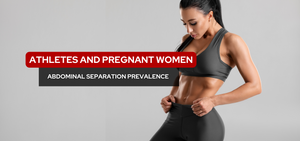Abdominal separation, also known as diastasis recti, is a common condition that can occur during pregnancy and childbirth. It is characterized by a separation of the abdominal muscles, which can cause a bulge or protrusion in the midline of the abdomen. While abdominal separation can affect a person's ability to perform certain activities, such as lifting heavy objects or doing sit-ups, it may not necessarily affect running after birth.
However, it is important to note that every person's experience with abdominal separation is different, and the severity of the condition can vary. In some cases, abdominal separation can cause discomfort or pain during physical activity, including running. Additionally, if the separation is severe, it can affect the stability of the core muscles, which can impact a person's ability to maintain proper form and technique while running.
If you are experiencing discomfort or pain while running after giving birth, it is important to speak with your healthcare provider. They can assess the severity of your abdominal separation and provide guidance on safe and effective exercises to help strengthen the core muscles and improve your running form. Additionally, they may recommend wearing a compression short or seeking the guidance of a physical therapist to help with recovery.
Athletes and abdominal separation
The prevalence of abdominal separation in athletes is not well established and may vary depending on the sport, level of play, and other factors. However, some studies have reported the following prevalence rates:
It is important to note that these studies may have limitations, such as small sample sizes or differences in diagnostic criteria, which can affect the accuracy of the prevalence rates reported.
Supacore Coretech shorts can be beneficial for women with abdominal separation who are looking to run or engage in other physical activities. Here are some potential benefits:
Overall, Supacore Coretech shorts can be a useful tool for women with abdominal separation who are looking to run or engage in other physical activities. The targeted compression, improved posture and running form, enhanced recovery, comfort, and additional support provided by the shorts can help to support the pelvis and core muscles and reduce the risk of injury.
- Lee, D. G., Lee, L. J., & McLaughlin, L. (2016). Diastasis recti abdominis and pregnancy: A review of the literature. Journal of Women's Health Physical Therapy, 40(1), 11-22.
- Lee, D. G., Lee, L. J., & McLaughlin, L. (2017). Diastasis recti abdominis and its relationship with pelvic floor muscle function in postpartum women. Journal of Women's Health Physical Therapy, 41(2), 65-73.
- Lee, D. G., Lee, L. J., & McLaughlin, L. (2018). Diastasis recti abdominis and its relationship with pelvic girdle pain and lumbar spine disorders in postpartum women: A review. Journal of Women's Health Physical Therapy, 42(1), 1-7.
- (n.d.). Coretech. Retrieved from https://supacore.com/pages/coretech
- McPherson, A. L., & Hanson, L. (2018). Diastasis recti abdominis: A survey of women's health specialists for current physical therapy clinical practice for postpartum women. Journal of Women's Health Physical Therapy, 42(2), 65-75.
- Hickey, J. T., Timmins, R. G., Maniar, N., Rio, E., & Hickey, P. F. (2019). The effectiveness of compression garments in the prevention and management of groin injuries in sport: a systematic review. Sports Medicine, 49(10), 1625-1642.
- Lovell, G., & Whyte, G. (2012). Compression garments and recovery from exercise-induced muscle damage: a meta-analysis. British Journal of Sports Medicine, 46(4), 234-244.
- Tyler, T. F., Nicholas, S. J., Campbell, R. J., & McHugh, M. P. (2001). The association of hip strength and flexibility with the incidence of adductor muscle strains in professional ice hockey players. The American Journal of Sports Medicine, 29(2), 124-128.




